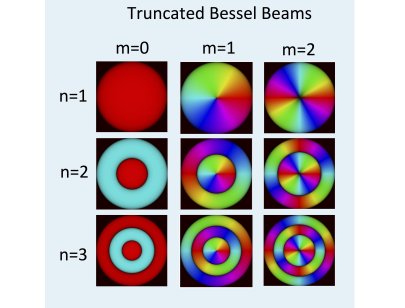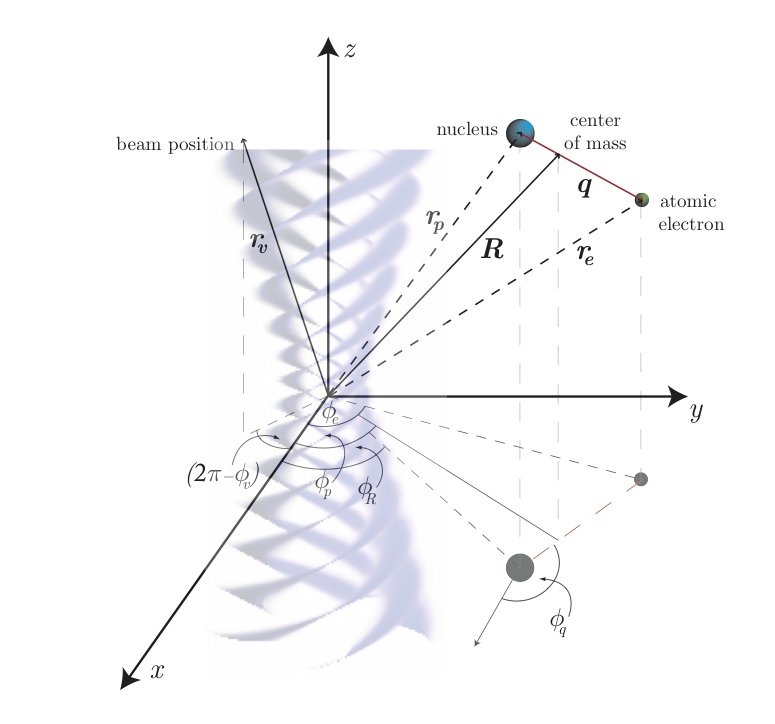Mission Statement
We aim to develop a fundemental understanding of the generation and propagation of electron beams and their interaction with matter and light. Our goal is to use such understanding to study fundamental quantum mechanics on the one hand and to develop new electron/optical based material characterisation tools as well. In parallel, we also investigate the growth and ultrastructure of novel nanomaterials to understand the physics and materials in nanoscale, applying our deep knowledge of physics behind the electron beam based characterisation techniques.
Research Interests and Highlights
Electron vortex beams and beam shaping
Electron vortex beams are unusual as their wavefunctions contain topological defects such as screw dislocations in wavefronts. At the dislocation cores, the phase is indeterminate, hence its wave amplitude is identically zero. Our research aims to develop various methods of production and understanding their unusual characteristics such orbital angular momenta as well as their interaction with atoms and molecules.
 |
Normal modes and mode transformation of pure electron vortex beams G. Thirunavukkarsu, M. Mousley, M. Babiker and J. Yuan Phil. Trans. R. Soc. A 375, 20150438 (2017) Publisher's copy (open access) The natural basis for describing electron vortex beams is presented and experimentally verified. |
|
 |
Quantized Orbital Angular Momentum Transfer and Magnetic Dichrotism in the Interaction of Electron Vortices with Matter Sophia Lloyd, Mohamed Babiker, Jun Yuan Phys. Rev. Lett. 108,074802 (2012) Publisher's copy Country to the interaction of optical vortex beams with atoms, OAM transfer between vortex electron beams and internal electronic excitation in atoms is found to be allowed in the experimentally dominant dipole coupling region. (Electron vortex project) |
|
Development in electron microscopy and related techniques
We are always interested in developing quantitative and novel electron microscopy and spectroscopy methods in order to understand better the materials in nanoscale. The hardware development is now increasingly carried out in conjunction with sophisticated simulations.
 |
Modeling Nanoscale Inhomogeneities for Quantitative HAADF STEM Imaging Richard Averyard, Riccard Fernando, Roy L. Johnston and Jun Yuan Phys. Rev. Lett. 113, 075501 (2014) Publisher's copy Realistic ab-initio HAADF-STEM image simulation of gold clusters, now the effect of surface atom vibration also included. |
|
 |
Cyclic twinning and internal defects of boron-rich nanowires revealed by three-dimensional electron diffraction mapping Xin Fu and Jun Yuan Nanoscale 5,9067-9072 (2014) Publisher's copy (open access) Structural analysis of multiple-twinned nanowires using electron diffraction tomography. |
|
Advanced Materials
Employing advanced materials characterization techniques, including but not exclusively electron microscopy and spectroscopy, we are interested in understanding the growth kinetics of novel materials such as boron-rich nanowires and nanoplates and two-dimensional transitional metal dichalcogenide monolayers as well as establishing the structure-properties relationships of both structural and functional materials from nuclear materials, nanoalloys for catalysts to magnetic thin films.
 |
Exploring atomic defects in molybdenum disulphide monolayers Jinhua Hong, Zhixin Hu, Matt Probert, Kun Li, Danhui Lv, Xinan Yang, Lin Gu, Nannan Mao, Qingliang Feng, Liming Xie, Jin Zhang, Dianzhong Wu, Zhiyong Zhang, Chuanhong Jin, Wei Ji, Xixiang Zhang, Jun Yuan and Ze Zhang Nature Communication 6, 6293 (2015) Publisher's copy (open access) Atomic scale imaging of point defects in 2D MoS2 monolayer and their dependence on the growth conditions |
|
 |
Understanding and controlling the structure and segregation behaviour of AuRh nanocatalysts L. Piccolo, Z. Y. Li, I. Demiroglu, F. Moyon, Z. Konuspayeva, G. Berhault, P. Afanasiev, W. Lefebvre, J. Yuan, R. L. Johnston Sci. Rep. 6, 35226 (2016) Publisher's copy (open access) Atomic scale imaging of phase segregation within AgRh catalytic nanoparticles on TiO2 support. (see more on nanoalloy project) |
|
